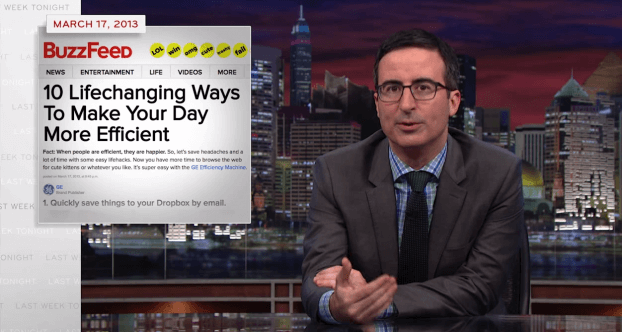Originally posted on Strategy Online – August 18, 2014
On his HBO show Last Week Tonight, comedian John Oliver recently took an admittedly pretty funny shot at the concept of native advertising. His basic point was that the blurring lines between objective content and marketing pieces threatens journalistic integrity and consumer trust in the media. Now, I find Oliver to be a funny and talented guy, and he’s done some spot on stuff (particularly his most famous piece on net neutrality). However, on this topic, he’s really off-base.
First, I think it’s important to offer a quick definition of native advertising. Broadly, native advertising is any kind of advertising that takes on the form and function of the content into which it’s placed. Classic examples of this in online advertising are Facebook’s sponsored posts, Twitter’s sponsored tweets and Yahoo!’s stream ads. You could even make the argument that paid search ads are native advertising – sponsored listings showing up in pretty much the same format as the organic (or non-paid) listings. This type of marketing is everywhere, and all signs point to it becoming even more ubiquitous, particularly as news outlets try to come up with meaningful business models for their online properties. John Oliver evidently thinks this is a bad thing; I disagree. Done right, I think native advertising can solve the problem of funding good journalism in the digital age, while actually creating meaningful consumer connections and building (as opposed to eroding) trust.
Let’s start with what we all hate about advertising.
- It can be interrupting. TV and radio ads stop what I’m consuming and give me something else for a period of time. Online banner ads often take over my screen and get in the way of what I’m trying to find.
- It can be irrelevant. I’m exposed to tons of adverting messages that are clearly meant for people in broad demographic groups. This is just noise to me.
- It can be obnoxious. Lacking any real connection to the consumer, marketers often resort to being loud and provocative in ways that just further add to the cacophony of ad messages.
What, then, do we appreciate about advertising?
- It can give us value. Ads for offers for things I want are often quite valuable and welcome.
- It can meet actual needs. Ads for cars when I’m in market to buy a car are far more meaningful and interesting.
- It can even entertain us. When they’re targeted to our demographics, interests and tastes, ads can actually be a source of real entertainment.
When you look at it that way, native advertising formats have the potential to be some of the most effective and least offensive forms of advertising out there. But Oliver’s concern is that this will erode the integrity of journalism when applied to online news properties. He views the rise of native advertising in this context as further evidence of undue corporate influence over the media. This reflects a very outmoded paradigm of how news is delivered and how we can fund and encourage good reporting and journalism. Oliver even says in the piece that “print is still where most original journalism is done.” I’m not sure what standard he’s applying to “original journalism,” but it’s clear to me that today most news is being broken online and the most meaningful and innovative reporting is never squeezed through a printing press.
The big problem, though (and Oliver points this out), is the business model. This really gets to the crux of the matter. People have decided collectively that they are not willing to pay for content online. Some notable exceptions persist, but by and large, the consumer expectation is that news (and most other content) online will be free and readily accessible. The other issue, pointed out in the piece, is that serving banner ads on a newspaper’s website, does not demand the same level of revenue or engagement as an ad presented in the confined spaces of a print publication. That leaves news outlets with a pretty big problem. While it sounds very lofty to talk about keeping the business and editorial sides of a news outlet separate (often compared to the separation of church and state), without the business side, there soon enough will be no editorial side. That’s where native advertising has come in. In the case of a news property, a native ad would be in the format of a news story or headline. That ad could be targeted based on the content of the page, the user’s online behavior, the user’s location and a host of other possibilities. In other words, that native ad has the potential to be very relevant to that user. As a user, that’s a much better experience than a block of ads on television or radio that interrupt what I’m watching. It’s also much better than a huge banner ad that takes over my screen and gets in the way of what I’m looking for.
Even Oliver wouldn’t argue that native ads are a pretty good business answer to the problems of the online news media. So, what about the issue of trust? Oliver quotes New Yorker contributor Ken Auletta as saying that native ads are “camouflaged” to look like news stories. This is where the fundamental misunderstanding about what native advertising is comes into play. In the clip, Oliver is very focused on this idea that native advertising is inherently about tricking people into thinking they’re consuming editorial content when you’ve really adroitly slipped in an advertisement. That sounds pretty nefarious and tricky. Oliver uses the extreme example of a sponsored story from the Church of Scientology on The Atlantic‘s website to punctuate his point. This is my biggest problem with Oliver’s argument. He uses a few narrow (and admittedly egregious) examples to impugn a concept that is quite broad and diverse. I realize it’s a comedy show, and nuance is certainly not going to win out over laughs, but he’s also trying to make a very real point – namely that native advertising is dangerous and needs to be shouted down by empowered consumers. That’s the wrong way to look at it. Native advertising has the potential to solve a lot of the problems that consumers have with marketing, while serving as the funding mechanism for really meaningful journalism going forward. A well done native ad is a placement that flows with the format of the site. It’s not trying to trick the user into something it’s not. Like other headlines on a news site, a good native ad should grab the attention of the reader because it’s interesting. One thing we do need, though, is a standard for labeling this kind of sponsored content. Some kind of icon with size parameters would be a good idea. This could apply to news sites and any other site using native advertising. That way consumers would get used to seeing it across properties, cluing them in to what is marketing and what is editorial or “organic” content.
The bottom line is that this advertising works, and, like it or not, we will be seeing more and more of it. As marketers and consumers, we need to demand appropriate standards and practices in the industry, but we also need to get beyond this idea that marketers trying to get targeted messages to consumers is inherently bad or subversive. Many of the marketers using native advertising are representing small to medium-sized businesses who just want to find effective and efficient ways to reach their customers in a rapidly-changing media environment. This is not about some corporate boogeyman trying to take over the news media. Rather, it’s a potential business model for funding really good journalism, where businesses, in a clear and transparent way, can also connect with their customers by providing relevant, valuable content.
As for John Oliver, I’m glad he took the time to focus on this issue. Hopefully, his bringing it forward will only increase customer understanding (and I think ultimately adoption) of this emerging marketing format, while starting a conversation about how we can collectively make sure we do it right.
Interested in finding out more? Contact us today!




